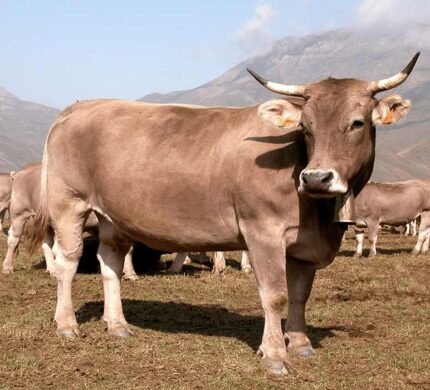Parda Alpina
- Temperature:Hot and cold weather
- Milk:4,000 to 6,000 pounds of milk per year
- Food:Plants and Grasses
- Pregnancy:280 days
- Nationality:Switzerland, Italy, and Austria

General Information
Parda Alpina, also known as the Swiss Brown, is a breed of cattle that originates from the Alpine regions of Switzerland, Italy, and Austria. They are well-adapted to living in mountainous areas and are highly valued for their ability to graze on steep, rocky terrain and withstand harsh weather conditions.
Parda Alpina cattle are medium-sized with a distinctive brown coat that ranges from light brown to almost black. They have strong, sturdy bodies with short legs and a broad chest, which allows them to move easily over rough terrain. They are known for their docile temperament and are easy to handle, making them a popular choice for small-scale, traditional farming systems.
In addition to their ability to thrive in mountainous regions, Parda Alpina cattle are highly valued for their milk and meat.
Where we find this cow to buy?
Here are some resources that may help you find Parda alpina cattle for sale:
If you are interested in buying Parda Alpina cattle, it is best to search for breeders and farmers in the Alpine regions of Switzerland, Italy, and Austria, as well as other countries where the breed is raised.
The Swiss Brown Cattle Breeders Association in Switzerland can be a good starting point for finding breeders of Parda Alpina cattle.
You can also try contacting local agricultural organizations or searching online for Parda Alpina breeders or farms in your area.
However, it is important to note that Parda Alpina cattle may not be readily available for purchase in all parts of the world, as they are a specialized breed with a relatively small population.

How to increase milk production in Parda Alpina
There are several ways to increase milk production in Parda Alpina cattle:
01
Providing Parda Alpina cows with a balanced diet is essential for optimal milk production.
02
Proper management practices can help reduce stress on cows and maximize milk production.
03
Providing cows with clean and fresh water is essential for optimal milk production.
04
Selecting Parda Alpina cows with desirable milk production traits can improve milk production over time.
Medicine
There are several types of medicine that may be used for Parda Alpina cattle:
01
AntibioticsMedications used to treat bacterial infections in cattle are available in various forms and topical formulations.
02
DewormersMedications are used to control parasites in cattle, such as oral drenches, injectable solutions, and topical sprays.
03
VaccinesVaccines stimulate the cow’s immune system to produce antibodies to prevent diseases such as BVD, IBR, and leptospirosis.
04
NSAIDsThese medications are used to treat pain and inflammation in cattle, such as fever, lameness, or mastitis.
Pregnancy
The first step in pregnancy is breeding, where the cow is bred with a bull either through natural mating or artificial insemination.
Towards the end of the gestation period, a clean and comfortable calving area should be prepared for the cow to give birth.
The cow enters the parturition or birthing stage, exhibiting signs of labor such as restlessness, udder swelling, and discharge from the vagina.
The cow should receive adequate nutrition and care during the gestation period to support the developing calf.
The calf should be dried and disinfected after delivery, and the umbilical cord should be tied off and disinfected.
Monitoring and consultation with a veterinarian is recommended during the gestation period.
Important!
After delivery, the cow and calf require postpartum care, including monitoring for any signs of complications, such as retained placenta or infection. The calf should receive colostrum, which provides essential nutrients and antibodies to the calf, and the cow should receive proper nutrition and care to support lactation.
Food
The diet of Parda Alpina cows typically includes the following types of food:
The cows graze on fresh grass during the spring and summer months. This provides them with essential nutrients, including carbohydrates, protein, and fiber.
Hay is harvested grass that is cut and dried for winter feeding. It is an important source of nutrients during the winter months when fresh grass is not available.
Silage is made by fermenting chopped grass, and is another important source of nutrition during the winter months.
Parda Alpina cows may be given protein and mineral supplements to ensure adequate nutrition, such as soybean meal, corn gluten meal, and other grains.
Facts
Here are some facts about Parda Alpina:
Parda Alpina, also known as Brown Swiss, is a breed of domestic cattle that originated in Switzerland.
They are well adapted to grazing in mountainous terrain and have strong legs and feet to navigate steep slopes.
Parda Alpina cows are known for their high milk production and are widely used for dairy farming.
Parda Alpina cows have a gentle and docile temperament, making them easy to handle and work with.
The breed is known for its longevity, with cows often continuing to produce milk for over a decade.
Parda Alpina cows are used for meat production, producing high quality and well-marbled meat.
The breed has been exported to many countries, and is now found in Europe, North America, and Asia.
They are also used in crossbreeding programs to improve the milk and meat production of other breeds of cattle.